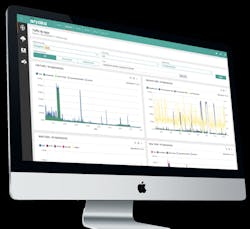Digital transformation is poised to deliver tremendous efficiencies and cost savings through the integration of digital technology into all aspects of a business, from the front offices and the assembly line, to the supply chains and retail locations, and ultimately to the consumer. And this transformation requires a more intelligent and cloud-first approach to the WAN: the Wide Area Network that connects it all.
As vast amounts of data are being harvested by the Industrial Internet of Things (IIoT), machine learning and artificial intelligence (AI) have come into their own, allowing global manufacturers to store all incoming data for analysis and refinement. Yet, true digital transformation of a manufacturing operation requires global integration to get all the data flowing from the factory floor through analysis, and up to the central HQ and cloud for real-time decision making.
Real-time responses to market changes are foundational to the Fourth Industrial Revolution.
This foundation requires a robust network architecture capable of transporting terabytes of data generated from the factory floor, prioritizing mission-critical data from manufacturing systems, supporting cloud-based office productivity and customer relationship management applications, and ensuring the machines running the algorithms have access to the data lakes. This requires a network that can manage a massive amount of data. Connection quality is critical to ensure all this data flows in the needed directions. To revisit a worn analogy—if the internet is a series of pipes, would you trust your proprietary data to leaky pipes, or would you want it flowing quickly, easily and worry-free?
Dealing with Data Volume
Huge amounts of data are being collected everywhere, from the factory floor to the POS terminals. More data generally means more insight into the complete product lifecycle. About 10 to 15 years ago, systems were designed to move data back and forth between the manufacturing line and operator devices such as terminals or CNC machines (east-west movement within a network), but no further. At the time, that was enough.
Today, pairing north-south data (over firewalls or outside the proprietary network) from the start of production with sales data gives retailers a tremendous advantage. Think of fast fashion using real-time sales data from stores to make immediate production, sewing and style decisions back at the factory, allowing them to get product to market in weeks instead of industry-typical months. This is a new phenomenon only possible today thanks to the cloud moving and coordinating both north-south and east-west dataflows.
The Cloud is Critical to Manufacturing
The tremendous amounts of data even a small production facility may generate in an average day is truly endless: schematics, change orders and customization, production metrics, error logs, SKUs, shipping information. Multiply it across manufacturing locations around the world and data generation becomes immense. In-house storage is one option, but the economies of scale enabled by cloud data providers combined with the processing power the cloud offers to analyze it means the costs often outweigh the benefits.
Amazon’s AWS, Google Cloud Platform and Microsoft Azure, among others, have recently been moving into manufacturing-oriented cloud options to serve this burgeoning market. As IT systems are upgraded and information is freed from the factory floor the data needs to be stored offsite—even across multiple cloud servers in varying geographies. Depending on their requirements, enterprises often rely on multiple cloud providers as part of their digital transformation efforts. It is increasingly common for a single enterprise to have a planned multi-cloud approach based on resiliency, cost and geography.
In addition to sending the data offsite to be analyzed, it is also important to prioritize certain types of data over others. For instance, sending emergency spec updates for the latest widget to the CNC machines must take priority over the daily timesheets. Think of this as traffic control—if every classification of information was sent over a network willy-nilly, the system would quickly bog down under its own weight—and wait. Prioritizing traffic flow is vital.
Makino: Moving Big Files
Makino, a leading tool manufacturer for a range of vertical industries, was running out of patience with the Wide Area Network linking company facilities in North America, Asia and Europe. It was taking too long for data to synchronize across locations, increasing the chance employees would be working off old data. The company realized its static, legacy MPLS (Multiprotocol Label Switching) backbone would be a limitation when it came to moving aggressively to the cloud.
Machine manufacturing equipment production involves transferring large data files of machine schematics, drawings and statistics. With legacy MPLS networks, it was taking six to seven hours to synchronize data between the Tokyo headquarters and the tech center in Mason, Ohio.
Additionally, MPLS deployment times were notoriously long because circuits had to be coordinated with multiple carriers all the way down to the last mile, creating months of delays in new site rollouts and reducing the ability to set up new locations quickly. A final nail in the coffin of MPLS was that the company was in the process of moving over 90% of its applications to the cloud.
The Solution: Cloud-First SD-WAN Networking
Makino chose a fully managed software-defined wide area network (SD-WAN) service to link all their facilities. Makino connected their facilities to a local point of presence (PoP) using short, dedicated internet links. From there, the company’s traffic was optimized for transport across various PoPs to anywhere in the world. Deduplication and caching technologies help groom traffic, limit packet loss and deliver low (and consistent) latency end-to-end, which ultimately improved Makino’s data synchronization efforts. The technology also paved the way for the company’s migration to the cloud and improved the performance of voice and video communications among the company’s far-flung operations.
With Makino’s SD-WAN implementation operational for nearly a year, schematic file transfer times from Japan to Europe and North America have fallen from six to seven hours to just 22 minutes. Makino is more responsive to customer needs, and new competitive advantages have opened up. Data and applications are now delivered to every end-user as if they resided in the local server. While the organization has further to go in its digital transformation journey, the infrastructure is now in place to future-proof its cloud and networking needs.
Arun Natarajan is director of product marketing at Aryaka.



